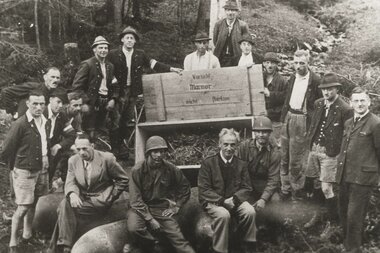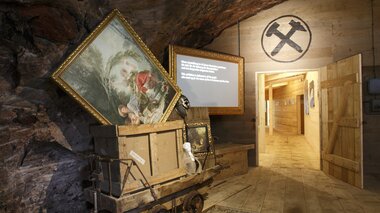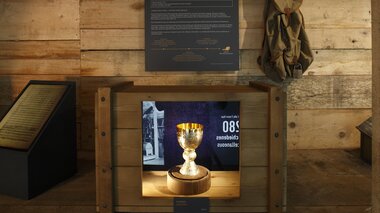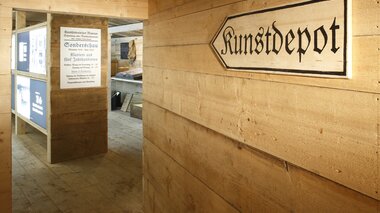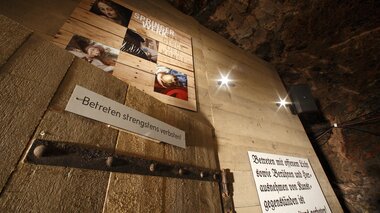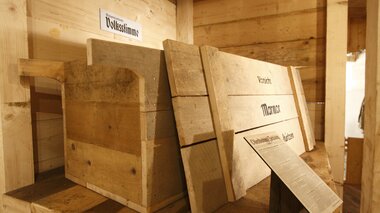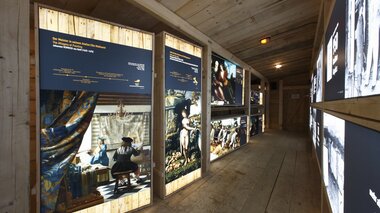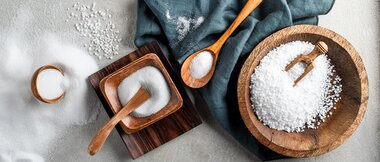The history of Altaussee salt mine: Of the Middle Ages, “Monuments Men” and 1.47 million m³ of brine
The Altaussee salt mine in Ausseerland, Styria, looks back on a colorful – and in some cases, movie-worthy – history, extending from the High Middle Ages to the present day. And perhaps unexpectedly, its story isn’t always about salt. But rather, art treasures of inestimable value, Nazi bombs that were never detonated and courageous Aussee miners…. Sound exciting? Well, it is! So exciting in fact, that this chapter of Altaussee mining history was filmed with a cast of Hollywood stars.
Hollywood in Altaussee: How the “Monuments Men” met courageous miners from Altaussee …
The story that played out at the Altaussee mine during the last years of the Second World War, would eventually provide the material for a Hollywood “flick” with a star cast. The movie entitled “The Monuments Men”, starring George Clooney along with other Hollywood A-listers such as Matt Damon and Bill Murray, tells the story of how art treasures were rescued by the so-called “monuments men”. You see, the Nazis had stolen art treasures of incalculable value from across Europe and hidden them away, safe from Allied bombing, deep inside the mines. Facing defeat, Adolf Hitler issued the so-called “Nero Order”. In other words, the artworks stowed away in the mines, along with anything else that might be important to the enemy, were to be destroyed. For the monuments men, this meant a race against time, a race which also led them to the mine here in Altaussee …
The true story of how the artworks were rescued: the “Mountain of Treasures”
A Madonna by Michelangelo, paintings by Rubens and Rembrandt, the Ghent Altarpiece by the van Eyck brothers, the Tassilo Chalice, works by Dürer and Vermeer – art of inestimable value came within a hair’s breadth of being blown up in 1945 during the last weeks of the war! But let’s start right back at the beginning of the story: As the German Reich began to collapse and the Allies were bombing German cities, the National Socialists, who had looted treasures across the length and breadth of Europe, began to hide those treasures underground. The idea was that the mines would protect the paintings, sculptures and other priceless objects from the bombs of the enemy. However, they were in no way protected from the insanity of the Führer himself: In spring 1945, the dictator gave the order from Berlin that, in the event of defeat, everything the German people had created – factories, roads, bridges, art – was to be destroyed. This so-called “Nero Order” also included the artworks in the tunnels of Altaussee, which had originally been destined for a “Führer Museum” in Linz. Hitler would revoke this order a little later.
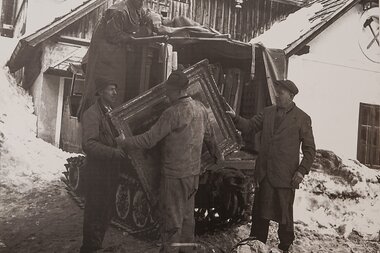
When the Altaussee miners became heroes
However, the Gauleiter of the Upper Danube District (which also included the Styrian Salzkammergut), a certain August Eigruber, was a fanatical National Socialist. He did everything in his power to implement Hitler’s original order and destroy the artworks in the Altaussee salt mine. To that end, he ordered eight unexploded bombs that had been dropped by the Americans during air raids over Linz, to be brought into the mine tunnels of Altaussee. To disguise the explosive contents, he had the crates labeled “Caution: Marble, do not drop”. But the Altaussee miners grew suspicious, which in turn began a race against time. Ultimately, the miners succeeded at the last second in saving the art treasures from destruction. Created in 2019, the exhibition entitled "The Fortune of Art" documents those finals days of the war and the spectacular rescue of the art treasures. If, during your tour of the Altaussee salt mine, you peer into the murky depths of the Sandling Berg, you can well imagine how it must have been back then when Michelangelo’s Madonna, the Ghent Altarpiece and priceless paintings were stored far underground. Or how might it be, if George Clooney and Matt Damon suddenly sprang out from behind the next bend in the tunnel…
To the BBC contribution about the art treasure salvage in AltausseeThe Fortune of Art - Experience the spectacular rescue of the art treasures in 3D
Here you can virtually zoom into the Altaussee salt mine and explore the true story of how the artworks were rescued during the last days in WWII:
Special Tip: Special tour “Bombing Michelangelo”
How did the brave Altaussee miners manage to save the priceless art treasures from destruction and why did some of those treasures surface a little later in the backrooms of nearby inns – you will learn all about this in a special 90-minute tour entitled “Bombing Michelangelo”.
Curious to know the true story? Then go ahead and register yourself and your group for an upcoming special tour right now, either by E-mail or phone +43 (0) 6132 200 2400!
The biggest active salt mine in Austria
The salt mine doesn’t only look back on a colorful past: It’s a hive of activity even today! In addition to the historic mine that is open to visitors, Altaussee happens to also be the biggest active salt mine in Austria! There are currently 30 active mining sites and 18 drilled probe holes manned by the 57 people working inside the mine. Annual brine production amounts to around 1.47 million cubic meters – equating to 500,000 tons of salt, which Salinen Austria AG then processes into a wide range of products. Kitchen salt for your dining table, salt for the swimming pool, as well as salt used as an essential component of medical and cosmetic products. In fact, you will come across salt from Austria’s biggest active salt mine practically everywhere!
The salt mine in Altaussee – from the Middle Ages until today
|
1147 |
Salt mining in Altaussee is first chronicled; the mine and saltworks are controlled by Rein Abbey, located near Graz |
|
1211 |
Mining and processing rights are nationalized by Duke Leopold VI; the saltworks is relocated from Augstbach to Unterlupitsch |
|
ca. 1285 |
The “salt pans” are again relocated, this time to Bad Aussee |
|
1319 |
Tunneling work begins on the Steinbergstollen |
|
1334 |
New, bigger processing facilities are installed in Bad Aussee – production rises to around 10,000 tons of salt annually! |
|
1334 - 1449 |
Heyday of medieval salt mining under the management of the private Hallinger Gewerkschaft |
|
1449 |
Salt production renationalized by Emperor Friedrich III |
|
ca. 1550 |
120 workers are employed at the mine |
|
17th – 19th cent. |
Annual salt production stagnates at about 10,000 tons |
|
1906 |
A new brine pipeline opens; production quadruples; record workforce (238 employees) |
|
1943 – 1945 |
Nazis hide looted art treasures inside the mine – Aussee miners protect the artworks from destruction |
|
1948 |
Tunneling work begins on the Erbstollen |
|
1965 |
Conversion from brine production to a process involving drill probes |
|
2020 |
57 workers generate around 1.47 million cubic meters of brine from 18 drill probes annually – producing 500,000 tons of pure salt |
